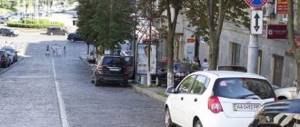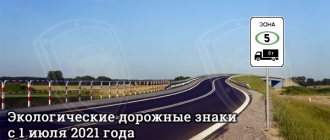These requirements do not apply to guest parking - the car can be parked temporarily anywhere in the yard, of course, if you do not violate traffic rules.
- Decree of the Government of the Russian Federation of October 23, 1993 No. 1090 “On Traffic Rules”.
The traffic rules do not contain the concept of “yard”, but it is said that the same rules apply in courtyards as in residential areas.
10.2. In populated areas, vehicle traffic is permitted at a speed of no more than 60 km/h, and in residential areas, bicycle zones and courtyard areas, no more than 20 km/h.
17.2. In a residential area, the through traffic of motor vehicles, practice driving, parking with the engine running, as well as parking of trucks with a permissible maximum weight of more than 3.5 tons outside specially allocated and marked areas with signs and (or) markings is prohibited.
17.3. When leaving a residential area, drivers must give way to other road users.
17.4. The requirements of this section also apply to courtyard areas.
To understand whether the driver is violating clause 17.2 of the rules, you need to know what parking is and how it differs from stopping.
Clause 1.2 of traffic regulations
“Stopping” is a deliberate cessation of the movement of a vehicle for up to 5 minutes, as well as for longer if this is necessary for boarding or disembarking passengers or loading or unloading the vehicle.
“Parking” is the intentional interruption of the movement of a vehicle for a period of more than 5 minutes for reasons not related to the embarkation or disembarkation of passengers or the loading or unloading of the vehicle.
- “Code of the Russian Federation on Administrative Offenses” dated December 30, 2001 No. 195-FZ.
According to Article 12.28 of the Code of Administrative Offenses of the Russian Federation, those who violated the rules when driving in a residential area (which is the courtyard of an apartment building) must pay 1,500 rubles
.
The fine for the same violation in Moscow and St. Petersburg
is twice as large -
3,000 rubles
.Let's take a closer look at cases of improper parking in courtyards.
Half a car on the sidewalk
As we said above, you cannot park the car so that one part of it is on the sidewalk and the other on the road. Parking on the edge of the sidewalk is permitted only if there is a parking sign in this place and one of the signs expressly allowing such parking.
Clause 12.2 of the Russian Traffic Regulations:
parking on the edge of the sidewalk bordering the roadway is permitted only for cars, motorcycles, mopeds and bicycles in places marked with sign 6.4 (“Parking”) with one of the signs 8.4.7 (indicates the type of vehicle covered by the sign) , 8.6.2, 8.6.3, 8.6.6 - 8.6.9 (indicate the method of parking cars and motorcycles in sidewalk parking).
A driver who leaves a car on the sidewalk (if there are no special signs or plates nearby that allow this) will receive a “chain letter” worth 1,000 rubles if a violation is recorded. In Moscow and St. Petersburg, the fine for such a violation is higher: 3,000 rubles.
Code of Administrative Offenses of the Russian Federation, Article 12.19:
3. ...violation of the rules for stopping or parking vehicles on the sidewalk, with the exception of the case provided for in Part 6 of this article, shall entail the imposition of an administrative fine in the amount of one thousand rubles.
6. Violations provided for in parts 3 - 4 of this article, committed in the federal city of Moscow or St. Petersburg, entail the imposition of an administrative fine in the amount of three thousand rubles.
Sanctions for traffic violations
If a car or other mechanical vehicle is parked on a pavement intended for pedestrians, the owner should expect penalties. For such an illegal act, an administrative fine is provided in accordance with Part 3 of Article 12.19 of the Code of Administrative Offenses of the Russian Federation in the amount of 1,000 rubles, except for the cities of Moscow and St. Petersburg, in which the amount of this penalty is 3,000 rubles.
If a car interferes with the passage of pedestrians, its owner is obliged to pay an administrative fine. The car may be towed to a parking lot, which will bring additional costs and time to the owner. A fine for parking on the sidewalk can be imposed as many times as this offense is recorded.
To park in the wrong place, you need to drive through it. A careless driver needs to know what fine awaits him for driving on the sidewalk. In accordance with Part 2 of Article 12.15 of the Code of Administrative Offenses of the Russian Federation, the protocol imposes a penalty in the amount of 2,000 rubles.
Parking with the engine running under the windows
According to clause 17.2 of the Russian Traffic Regulations, parking with the engine running in the yard is prohibited. But here it is necessary to distinguish between the concepts of “stop” and “parking”, which we wrote about above. Time and purpose are taken into account. Drivers, of course, always turn this to their advantage, hoping that no one will prove anything. Therefore, it is difficult to hold people accountable for the fact that an engine rattled for 20 minutes in the yard.
In this situation, video recording will help. You can film the offender on your phone. And if video cameras are installed in the yard (on the house) and they recorded the violating driver, you can take these recordings and attach them as evidence to the complaint to the traffic police.
Code of Administrative Offenses of the Russian Federation Article 28.1:
1. The reasons for initiating a case of an administrative offense are:
4) recording an administrative offense in the field of traffic
or an administrative offense in the field of improvement of territory, provided for by the law of a constituent entity of the Russian Federation, committed using a vehicle or the owner or other owner of a land plot or other property,
operating automatically with special technical means that have the functions of photography, filming, video recording, or means photography, filming, video recording
.
The violator, under Article 12.28 of the Code of Administrative Offenses of the Russian Federation, will be fined 1,500 rubles, and if the case occurs in Moscow or St. Petersburg - 3,000 rubles.
Which driver stopped correctly to unload passengers?
| 1. | Only A. |
| 2. | Only in. |
| 3. | A and B. |
| 4. | B and V. |
Answer
- On the left side of one-way roads (one-way road sign) in populated areas, stopping and parking of vehicles is allowed (where driver “A” stopped).
- On roads with a lane for route vehicles (sign 5.14, markings in the form of the letter “A”), driving and stopping other vehicles in this lane (where driver “B” stopped) is prohibited.
- Passengers should board and disembark from the sidewalk or curb, and not in the middle of the roadway where driver “B” stopped.
Therefore, only driver “A” did not violate.
Minibuses in the yard at night
If buses or minibuses are parked in your yard overnight, this is a violation. You have the right to write a statement to the traffic police. The fines for the driver, officials and the organization that owns the bus are impressive.
Part 3 of Article 11.33 of the Code of Administrative Offenses of the Russian Federation:
Parking a bus, tram or trolleybus used for regular passenger transportation at night outside the designated areas shall entail the imposition of an administrative fine on the driver in the amount of five thousand rubles; for officials - ten thousand rubles; for legal entities - twenty thousand rubles
.
In what case can a fine be avoided?
There may be situations in which parking at a public transport stop is acceptable and is not considered a traffic violation. Such cases include:
- sharp deterioration in the driver's health:
- vehicle breakdown requiring immediate cessation of movement;
- a car skidding into the oncoming lane during a maneuver that could have prevented an accident.
Attention! To prevent interference, the driver must park the car at a maximum distance and set the hazard warning lights. If the reason is that the driver is not feeling well, you must call for help or give a sign to pedestrians.
It is allowed to stop in the wrong place if the vehicle has the following breakdowns:
- the steering or braking system is faulty;
- windshield wipers broke in bad weather;
- malfunction of external lighting at night.
These reasons may justify parking in the wrong place. If necessary, call the emergency service or tow truck.
The car interferes with traffic
If a car is parked in such a way that it interferes with the passage of other cars, or interferes with the passage of pedestrians or people with limited mobility (disabled people in wheelchairs, mothers with strollers), this, of course, is also a violation.
Clause 12.4 of the Russian Federation Traffic Regulations:
Stopping is prohibited:
... in places where the distance between ... the opposite edge of the roadway and a stopped vehicle is less than 3 m;
... in places where the vehicle ... will make it impossible for other vehicles to move (enter or exit) (including on bicycle or bicycle-pedestrian paths, as well as closer than 5 m from the intersection of a bicycle or bicycle-pedestrian path with the roadway), or interfere with traffic pedestrians (including at the junction of the roadway and sidewalk on the same level, intended for the movement of people with limited mobility).
If you notice this, notify the traffic police after taking a photo of the vehicle parked in the wrong place. The violator may first be given a warning and then forced to pay a fine of 500 rubles.
Part 1 of Article 12.19 of the Code of Administrative Offenses of the Russian Federation:
1. Violation of the rules for stopping or parking vehicles, except for the cases provided for in Part 1 of Article 12.10 of this Code and Parts 2 - 6 of this Article, entails a warning or the imposition of an administrative fine in the amount of five hundred rubles.
Signs and markings regulating stopping on the side of the road
Places where stopping is prohibited are indicated by sign 3.27. It is represented by a circle with a blue background. Red border. The circle is crossed out diagonally by two intersecting red lines.
Its effect applies to any passenger or truck vehicle, but not to minibuses and public transport.
Typically used with yellow solid line markings (1.4). It duplicates the prohibition determined by the sign. The end of the marking indicates the lifting of the ban.
If the sign is installed separately, signs may be installed below indicating exactly the area where the prohibition applies and the direction in which it is in effect (8.2.2 to 8.2.6 inclusive).
In the absence of signs, the ban is lifted only at the first intersection or by indicating the beginning (end) of the settlement.
Some signs directly indicate the duration of the restriction and the possibility of evacuating abandoned vehicles. For example, at night or during the day.
You are also allowed to stop in parking spaces. The sign is a square with a blue background, on which the letter P is depicted in white (6.4). Additional signs are also used with the sign (validity zones, for disabled people).
Attention must be paid to the sign indicating the required placement of vehicles in the parking lot, otherwise you may run into a parking fine.
To mark parking spaces, use a solid white line (1.1).
You cannot cross this solid line anywhere, including in the parking lot.
It usually also separates two different-directional traffic lanes and serves to ensure safety.
Another markup is similar to it - 1.2.1. But it has a slightly different function. In particular, the solid line on the side of the road serves to define the edge of the roadway, that is, there is a shoulder behind it.
There is no penalty for crossing such a solid line. If transport constantly travels outside its boundaries, we will be talking about a violation.
You can find yellow markings in the form of a broken line. It is used to indicate places where taxis and minibuses are allowed to stop. Other vehicles may be located here if you need to drop off a passenger or board him.
Trucks in the yard
As we have already established above, clause 17.2 of the Russian Traffic Regulations clearly states that trucks with a permissible maximum weight of more than 3.5 tons cannot be parked in a residential area. This is permissible only when there are special markings and corresponding signs.
But we are talking only about truck parking. You can make a stop. We know about the difference between stopping and parking. Therefore, if you need to hold a violating driver accountable, you can take a video of his parked truck - this will make it clear how long he has been standing in the yard. According to Article 12.28 of the Code of Administrative Offenses of the Russian Federation, the driver will pay 1,500 rubles. Or 3000 rubles - for Moscow and St. Petersburg.
Situations in which a fine is inevitable
If there is a prohibition sign 3.27, any parking is considered a traffic violation and the driver is fined. The sign's operating distance may be indicated under the sign. The only exceptions are illness of the driver or irreparable breakdown of the car. The driver of the vehicle also takes great risks and violates traffic rules in the following situations:
- when leaving the car at the crossing itself or in an area less than 5 meters from it;
- if the driver parked in a space reserved for disabled people;
- if standing on railway or tram tracks;
- if a car blocks the road for pedestrians and other vehicles;
- parking on the lawn, playgrounds, sidewalks.
I parked incorrectly in the yard
If you violated the parking rules in the yard and someone recorded it, you may receive a “chain letter”. You can check whether you have unpaid fines on the State Traffic Inspectorate website. The car can also be towed for improper parking, for example, if the car is parked on the lawn or sidewalk, in a place intended for the disabled.
It happens that work is planned in the yard - clearing snow, laying asphalt. Then announcements are placed in advance stating that parked cars need to be removed and that parking in this area should not be carried out during the work. If the requirements are not met, the car may be moved to a neighboring yard or impound lot.
Penalties
Violation of stopping rules is subject to administrative liability. The amount of the fine depends on the type and nature of the violation.
| Violation (description) | Article (Administrative Code) | Type and extent of punishment | |
| Fine (rubles) | Deprivation of rights (months) | ||
| The driver stopped at a railway crossing | 12.10 (part 1) | 1000 | 3–6 |
| The driver stopped again at a railway crossing | 12.10 (part 3) | — | 12 |
| The driver stopped the vehicle on the highway, not at a special site | 12.11 (part 1) | 1000 | — |
| The driver did not signal before the stop began | 12.14 (part 1) | 500 or warning | — |
| The driver stopped the car despite prohibiting signs and markings | 12.16 (part 4) | 1500 | — |
| 12.16 (part 5) The violation was committed in the city of Moscow (St. Petersburg) | 3000 | — | |
| The driver stopped the vehicle in the lane intended for minibuses | 12.17 (part 1.1) | 1500 | — |
| The driver violated stopping rules | 12.19 (part 1) | 500 | — |
| 12.19 (part 5) In Moscow (St. Petersburg) | 2500 | — | |
| The driver violated the rules of stopping in a place intended for disabled people | 12.19 (part 2) | 5000 | — |
| The driver stopped the vehicle at a zebra crossing or in a five-meter restriction zone (except for force majeure), as well as stopping on the sidewalk | 12.19 (part 3) | 1000 | — |
| 12.19 (part 6) In Moscow (St. Petersburg) | 3000 | — | |
| The driver stopped the vehicle at a stop for minibuses, taxis or in a 15-meter zone (with the exception of a forced stop or getting people on/off) | 12.19 (part 3.1) | 1000 | — |
| 12.19. (Part 6) | 3000 | — | |
| The driver stopped the car on tram tracks or parked it further than the first row of the road (except in force majeure) | 12.19 (part 3.2) | 1500 | — |
| 12.19 (part 6) | 3000 | — | |
| Transport was stopped in violation of the rules on the road and created an obstacle to traffic, or the stop occurred in a tunnel | 12.19 (part 4) | 2000 | — |
| 12.19 (part 6) | 3000 | — | |
In which of the following places can you stop by car?
| 1. | Only B. |
| 2. | Only A and B. |
| 3. | Only A and B. |
| 4. | In any. |
In populated areas on one-way roads, stopping cars is also allowed on the left side of the road. A no-stop sign with a coverage zone sign shows that the no-stop zone ends behind the signs (car B). In addition, the sign is valid only on the side of the road on which it is installed - therefore, its effect does not apply to car A. Therefore, you can stop at places A and B.
Where can you stop?
| 1. | Only in. |
| 2. | Only B and C. |
| 3. | In any. |
You can stop anywhere, since in built-up areas (sign beginning of a built-up area) on roads with one lane for each direction without tram tracks in the middle, stopping is allowed on both the right and left sides of the road.
Which driver violated the stopping rules?
| 1. | Nobody violated. |
| 2. | Only the bus driver. |
| 3. | Only the driver of a passenger car. |
| 4. | Both. |
Stopping and parking of vehicles is permitted on the right side of the road on the side of the road. On roads with one lane for each direction, stopping and parking on the left side of the road is only allowed in populated areas. Thus, the stopping rules were violated by both the driver of the car, who stopped outside the populated area on the left side of the road, and the driver of the bus, who stopped on the roadway when there was a shoulder .









